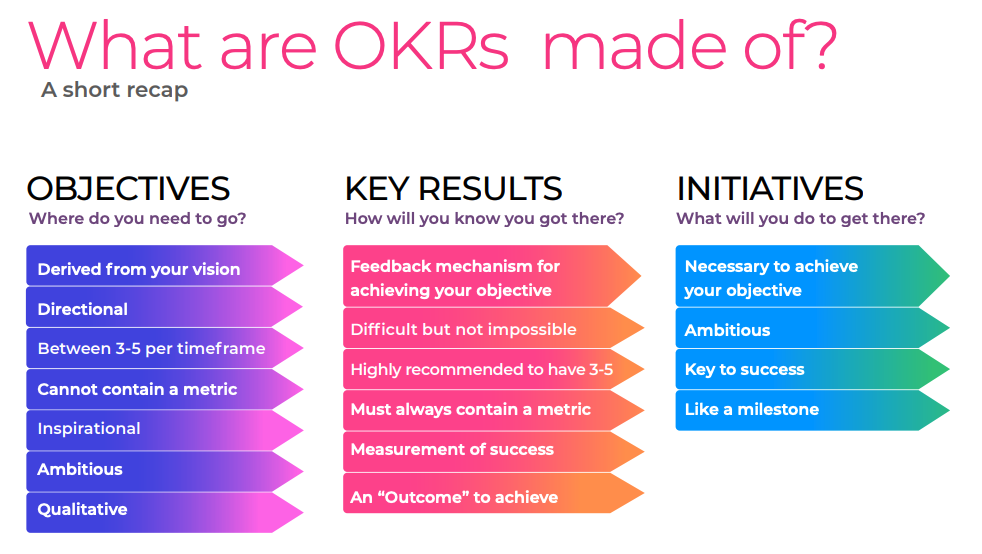SECTION
How to Write OKRs: The Ultimate Step-by-Step Guide

Listen to this article:
Note: This article was updated on April 1, 2025, with proven OKR formulas, common mistakes & tips to avoid them, and clear instructions for writing effective OKRs.
Objectives and Key Results (OKRs) are a robust framework high-performing organizations use to set, measure, and achieve business goals. Effective goal-setting provides a clear roadmap for success and can significantly enhance company productivity and teamwork.
This framework ensures that teams prioritize their efforts, measure progress toward strategic outcomes, and promote a more cohesive and purpose-driven approach. OKRs create clarity, encourage collaboration, and empower people to take ownership of their goals and outcomes.
In this guide, you’ll discover:
📌 Step-by-step instructions on how to write OKRs that deliver results;
📌 Common mistakes to avoid when writing OKRs and how to fix them;
📌 Proven OKR formulas and real-world examples for maximum impact;
📌 How to align OKRs with business goals for company-wide success.
By the end of this guide, you’ll have a deep understanding of how to write OKRs that inspire action, enhance accountability, and drive measurable success.
How to write an OKR: understanding the framework
In today's fast-paced and dynamic work environment, organizations constantly seek effective methods to drive success and achieve their goals. One popular method that has gained traction recently is the OKR framework.
By understanding the components of OKRs and their role in establishing a clear connection between results and objectives, teams can leverage this framework to drive performance and achieve organizational excellence.

Step 1: write strong objectives
Objectives are broad, qualitative goals defining what you want to achieve. Here’s how to write clear and motivating objectives:
- Make it ambitious yet attainable. Objectives should represent the directions that the company should always follow, the zenith if you will. Therefore, objectives should push your team forward but remain achievable.
- Use action-oriented language. Strong verbs help define clear objectives.
- Ensure strategic alignment. Groups or individuals can align with an objective and ideate the means to conquer the feat, the timing, and the specific milestones that pave the road ahead.
Here’s an example of a well-written objective: "Enhance customer retention by optimizing the onboarding experience."
💡Pro Tip: If your objective seems vague, ask, “Why does this matter?” to clarify its impact.
Step 2: write key results that measure success
Key Results, on the other hand, are specific, quantitative measures of success that track progress toward those objectives. To write key results effectively, follow these guidelines:
- Be specific. Use percentages, deadlines, and metrics. The right people for the job will always know if these are up to them and, subsequently, how they can contribute.
- Focus on outcomes, not tasks. Track results, not activities. A key result should be reachable, but the feeling of achieving it shouldn’t compare to a minor day-to-day accomplishment.
- Set a realistic number. 2–5 key results per objective are ideal.
Key result formula: [Key Result] = Action + What You’re Measuring + From X to Y
Here’s an example of well-written results for the above objective:
✔ Reduce customer churn rate from 15% to 8%
✔ Increase onboarding completion rate from 60% to 90%
✔ Improve new customer NPS from 6.5 to 8.5
💡 Pro Tip: If a key result doesn’t have numbers, it’s not measurable.
Step 3: the winning OKR writing formula
Organizations can create a roadmap that guides their efforts and ensures alignment by breaking down high-level objectives into measurable key results. This structured approach allows teams to prioritize initiatives, stay focused, and measure their impact on the organization's overall success.
💡 Pro Tip: Use this simple formula to structure your OKRs: “We will [Objective] as measured by [these Key Results]."
Examples of effective OKRs
Let’s explore some examples of well-defined OKRs across various business domains, showcasing how they can be structured to inspire action and drive results. By understanding these examples, you'll gain insights into the art of crafting impactful OKRs that propel your organization towards success.
HR OKR example
Objective: Enhance employee development and retention
Key Results:
- Implement a mentorship program with 100% participation from eligible employees.
- Increase employee satisfaction scores by 15% in the next quarterly survey.
- Reduce employee turnover rate by 10% compared to the previous year.
Marketing OKR example
Objective: Increase brand awareness and engagement
Key Results:
- Achieve a 30% increase in social media followership across all platforms.
- Generate 500 leads per month through inbound marketing efforts.
- Increase website traffic by 20% through content optimization and SEO strategies.
Sales OKR example
Objective: Accelerate revenue growth
Key Results:
- Achieve a 20% increase in monthly sales revenue compared to the previous quarter.
- Expand the customer base by acquiring 50 new clients within the next six months.
- Increase the average deal size by 15% through upselling and cross-selling initiatives.
Finance OKR example
Objective: Optimize cost efficiency and financial performance
Key Results:
- Reduce operational expenses by 10% through process optimization and resource allocation.
- Achieve a 15% increase in quarterly revenue compared to the same period last year.
- Improve cash flow management by maintaining a minimum cash reserve equivalent to three months of operating expenses.
Engineering OKR example
Objective: Enhance product innovation and quality
Key Results:
- Launch two major product updates with at least 90% positive feedback from beta testers.
- Reduce average software bug resolution time by 20% through improved testing and debugging processes.
- Increase system uptime to 99.99% through infrastructure enhancements and proactive.

How to avoid these common OKR writing mistakes
As with any new initiative, implementing OKRs may face resistance and roadblocks. Some common challenges that organizations might encounter include:
- Lack of buy-in from teams and employees;
- Resistance to change from traditional processes;
- Difficulty in aligning individual and team objectives with overall organizational goals;
- Unclear communication and understanding of the OKR methodology;
- Limited resources and time constraints;
- Writing too many OKRs;
- Using tasks instead of results;
- Writing vague or binary key results.
The first step is to recognize these potential challenges to stay proactive. Then, you should equip yourself with the right strategies to address these challenges proactively. Here are a few tips to implement easily:
- Educate employees on the benefits and value of OKRs.
- Clearly communicate the expectations, key results, and objectives to team members.
- Encourage regular updates from team members regarding their progress toward OKRs.
- Use real-time data to track and monitor progress.
- Adopt agile methodologies to help break down OKRs into smaller, manageable tasks.
- Limit each team to 3-5 OKRs per quarter to maintain focus.
- Write key results that measure impact, not just actions taken.
- Use gradual progress indicators (e.g., improve satisfaction from 70% to 90%).
Here are a few helpful resources to help you write effective OKRs:
- [eBook] How to Build Trust & Motivate Employees With OKRs
- [Checklist] Streamline HR Strategy With Our Complete HR OKRs Checklist
- [Case study] Mirro Helps Kooperativa 2.0 Unlock Potential with OKRs
- [Case study] Mirro Helps pastel Align Goals Across the Organization
- [Case study] Mirro Helps SeedBlink Align Team With Company’s Vision Through OKRs
How to align OKRs with business goals
Aligning individual and team OKRs with the broader company goals and mission is essential for promoting overall strategic alignment and driving success.
Through this alignment, leaders ensure that the team's initiatives and activities are directly linked to the company's strategic priorities, promoting a more cohesive and purpose-driven approach to daily tasks.
Before setting OKRs, ask yourself:
✔ Does this OKR contribute to a larger business goal?
✔ Are key teams aligned on this OKR?
✔ Can we track and measure this OKR over time?

Tips for ensuring alignment between team OKRs and company goals
- Collaborate with key stakeholders: engage with leaders and managers across the organization to understand their goals and align individual and team objectives with the overall strategic direction.
- Regularly communicate and review objectives: inform all stakeholders about objectives, progress, and necessary adjustments. Review objectives to ensure they remain relevant and aligned with shifting organizational priorities.
- Cascade objectives throughout the organization: break down team objectives into individual objectives to ensure alignment and accountability at every level.
- Use OKR software. OKR tracking software like Mirro helps leaders align their teams to company objectives and understand performance. With Mirro, you will know who does what at all times in your company, achieve complete transparency, enhance performance check-ins, and make informed decisions through workforce insights dashboards.
.png?width=758&height=483&name=OKRs%20(1).png)
Mirro's OKR software
Here’s an example of an aligned OKR 👇
Company Goal: Expand into international markets.
Sales OKR:
✔ Increase European market revenue from $2M to $5M.
✔ Sign 10 new partnerships in the UK & Germany.
✔ Increase European customer retention from 70% to 85%.
Final thoughts: mastering how to write OKRs
Adopting a goal-setting framework is a continuous and evolving journey that adapts to the company's requirements. With each new OKR, you will improve at writing, implementing, and monitoring them.
We hope this comprehensive guide gave you all the information you need to write good OKRs. We also encourage you to not focus only on completing your OKRs, but on having some fun while working on them.
By following this step-by-step guide, you’ll now know how to write OKRs that:
✔ Are clear, measurable, and outcome-driven.
✔ Align with business goals and drive success.
✔ Create motivation and accountability within teams.
Ready to start writing OKRs that deliver real impact? Try Mirro for free and transform how your team sets and tracks goals!
-
How do you write good OKRs?
-
What’s the best way to write key results?
-
How do OKRs differ from KPIs?
Use the formula: "We will [Objective] as measured by [Key Results]." Ensure objectives are action-oriented, and key results are measurable. Moreover, writing OKRs is a team effort. Therefore, everyone should sit at the table and contribute.
Use numbers, percentages, and clear targets. Avoid task-based key results—focus on outcomes instead.
OKRs define strategic goals and how to achieve them. KPIs measure ongoing business performance.






